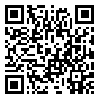Sat, Nov 23, 2024
[Archive]
Volume 14, Issue 1 (2-2022)
IJDO 2022, 14(1): 14-19 |
Back to browse issues page
Download citation:
BibTeX | RIS | EndNote | Medlars | ProCite | Reference Manager | RefWorks
Send citation to:



BibTeX | RIS | EndNote | Medlars | ProCite | Reference Manager | RefWorks
Send citation to:
Rahvarzadeh Z, Dehghanian M, Vahidi Mehrjardi M Y, Dehghani Ashkezari M. Investigating the Relation between LCK Gene Expression with Type 2 Diabetes Patients in Yazd Diabetes Research Center. IJDO 2022; 14 (1) :14-19
URL: http://ijdo.ssu.ac.ir/article-1-682-en.html
URL: http://ijdo.ssu.ac.ir/article-1-682-en.html
Zahra Rahvarzadeh 

 , Mehran Dehghanian
, Mehran Dehghanian 

 , Mohammad Yahya Vahidi Mehrjardi
, Mohammad Yahya Vahidi Mehrjardi 

 , Mahmood Dehghani Ashkezari *
, Mahmood Dehghani Ashkezari * 




 , Mehran Dehghanian
, Mehran Dehghanian 

 , Mohammad Yahya Vahidi Mehrjardi
, Mohammad Yahya Vahidi Mehrjardi 

 , Mahmood Dehghani Ashkezari *
, Mahmood Dehghani Ashkezari * 


Biology Department, Medical Biotechnology Research Center, Ashkezar Branch, Islamic Azad University, Ashkezar, Yazd, Iran.
Abstract: (1180 Views)
Type 2 diabetes mellitus (T2DM) is characterized by insulin resistance and insulin secretory defect. Deficiency of cellular immunity is known as one of the factors involved in the pathogenesis of T2DM. lymphocyte-specific protein tyrosine kinase( LCK) is an important gene involved in the intracellular signaling pathways of lymphocytes. This study aimed at determining and comparing LCK gene expression levels in diabetic patients compared with the healthy controls.
Materials and Methods: In this case-control study, 60 people, including 30 T2DM and 30 healthy people were included. The expression levels of the LCK gene were measured by real-time polymerase chain reaction and the obtained data were analyzed by T-test in GraphPad Prism6 software.
Results: The expression level of the LCK gene was increased in diabetic samples compared with the healthy samples (P= 0.0001).
Conclusion: The results suggested that changes in the expression levels of LCK gene can play a role in the pathogenesis of T2DM.
Materials and Methods: In this case-control study, 60 people, including 30 T2DM and 30 healthy people were included. The expression levels of the LCK gene were measured by real-time polymerase chain reaction and the obtained data were analyzed by T-test in GraphPad Prism6 software.
Results: The expression level of the LCK gene was increased in diabetic samples compared with the healthy samples (P= 0.0001).
Conclusion: The results suggested that changes in the expression levels of LCK gene can play a role in the pathogenesis of T2DM.
Type of Study: Research |
Subject:
Special
Received: 2021/10/28 | Accepted: 2022/01/15 | Published: 2022/02/26
Received: 2021/10/28 | Accepted: 2022/01/15 | Published: 2022/02/26
References
1. Zheng Y, Ley SH, Hu FB. Global aetiology and epidemiology of type 2 diabetes mellitus and its complications. Nature Reviews Endocrinology. 2018;14(2):88-98. [DOI:10.1038/nrendo.2017.151]
2. Wild S, Roglic G, Green A, Sicree R, King H. Global prevalence of diabetes: estimates for the year 2000 and projections for 2030. Diabetes care. 2004;27(5):1047-53. [DOI:10.2337/diacare.27.5.1047]
3. Chaudhury A, Duvoor C, Reddy Dendi VS, Kraleti S, Chada A, Ravilla R, et al. Clinical review of antidiabetic drugs: implications for type 2 diabetes mellitus management. Frontiers in endocrinology. 2017;8:6. [DOI:10.3389/fendo.2017.00006]
4. Papademetriou V, Lovato L, Tsioufis C, Cushman W, Applegate WB, Mottle A, et al. Effects of high density lipoprotein raising therapies on cardiovascular outcomes in patients with type 2 diabetes mellitus, with or without renal impairment: The action to control cardiovascular risk in diabetes study. American journal of nephrology. 2017;45(2):136-45. [DOI:10.1159/000453626]
5. Wanner C, Lachin JM, Inzucchi SE, Fitchett D, Mattheus M, George J, et al. Empagliflozin and clinical outcomes in patients with type 2 diabetes mellitus, established cardiovascular disease, and chronic kidney disease. Circulation. 2018;137(2):119-29. [DOI:10.1161/CIRCULATIONAHA.117.028268]
6. Watts NB, Bilezikian JP, Usiskin K, Edwards R, Desai M, Law G, et al. Effects of canagliflozin on fracture risk in patients with type 2 diabetes mellitus. The Journal of Clinical Endocrinology. 2016;101(1):157-66. [DOI:10.1210/jc.2015-3167]
7. Berbudi A, Rahmadika N, Tjahjadi AI, Ruslami R. Type 2 diabetes and its impact on the immune system. Current diabetes reviews. 2020;16(5):442. [DOI:10.2174/1573399815666191024085838]
8. Rahman F, McEvoy JW, Ohkuma T, Marre M, Hamet P, Harrap S, et al. Effects of blood pressure lowering on clinical outcomes according to baseline blood pressure and cardiovascular risk in patients with type 2 diabetes mellitus: the ADVANCE trial. Hypertension. 2019;73(6):1291-9. [DOI:10.1161/HYPERTENSIONAHA.118.12414]
9. Dehghan Tezerjani M, Vahidi Mehrjardi MY, Kalantar SM, Dehghani M. Genetic Susceptibility to Transient and Permanent Neonatal Diabetes Mellitus. International Journal of Pediatrics. 2015;3(6.1):1073-81.
10. Pickup JC, Crook MA. Is type II diabetes mellitus a disease of the innate immune system?. Diabetologia. 1998;41(10):1241-8. [DOI:10.1007/s001250051058]
11. Kolb H, Mandrup-Poulsen T. An immune origin of type 2 diabetes?. Diabetologia. 2005;48(6):1038-50. [DOI:10.1007/s00125-005-1764-9]
12. Bommhardt U, Schraven B, Simeoni L. Beyond TCR signaling: emerging functions of Lck in cancer and immunotherapy. International journal of molecular sciences. 2019;20(14):3500. [DOI:10.3390/ijms20143500]
13. Voronova AF, Sefton BM. Expression of a new tyrosine protein kinase is stimulated by retrovirus promoter insertion. Nature. 1986;319(6055):682-5. [DOI:10.1038/319682a0]
14. Bozso SJ, Kang JJ, Nagendran J. The role of competing mechanisms on Lck regulation. Immunologic Research. 2020:1-7. [DOI:10.1007/s12026-020-09148-2]
15. May MJ, Ghosh S. Signal transduction through NF-κB. Immunology today. 1998;19(2):80-8. [DOI:10.1016/S0167-5699(97)01197-3]
16. Fradin D, Bougneres P. T2DM: why epigenetics?. Journal of nutrition and metabolism. 2011;2011. [DOI:10.1155/2011/647514]
17. Hu FB. Globalization of diabetes: the role of diet, lifestyle, and genes. Diabetes care. 2011;34(6):1249-57. [DOI:10.2337/dc11-0442]
18. Cui C, Cui Y, Fu Y, Ma S, Zhang S. Microarray analysis reveals gene and microRNA signatures in diabetic kidney disease. Molecular medicine reports. 2018;17(2):2161-8. [DOI:10.3892/mmr.2017.8177]
19. Grayson BL, Wang L, Aune TM. Peripheral blood gene expression profiles in metabolic syndrome, coronary artery disease and type 2 diabetes. Genes & Immunity. 2011;12(5):341-51. [DOI:10.1038/gene.2011.13]
20. Downward J, Graves JD, Warne PH, Rayter S, Cantrell DA. Stimulation of p21 ras upon T-cell activation. Nature. 1990;346(6286):719-23. [DOI:10.1038/346719a0]
21. Zhang J, Somani AK, Siminovitch KA. Roles of the SHP-1 tyrosine phosphatase in the negative regulation of cell signalling. InSeminars in immunology. Academic Press .2000;12(4): 361-378. [DOI:10.1006/smim.2000.0223]
| Rights and permissions | |
 |
This work is licensed under a Creative Commons Attribution-NonCommercial 4.0 International License. |




